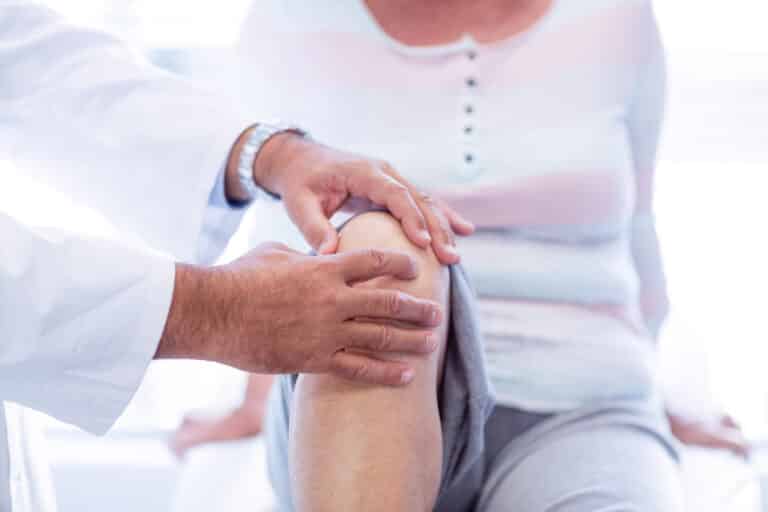Knee pain can be a major obstacle to enjoying everyday activities, especially for seniors. But did you know simple knee exercises for seniors can help prevent joint pain and improve balance?
Whether dealing with arthritis, past injuries, or just the natural wear and tear of aging, maintaining strong and flexible knees is essential for a healthy, active lifestyle.
In this article, we’ll explore the common causes of knee pain among seniors and reveal how targeted exercises can make a significant difference.
You’ll discover easy-to-follow routines that can be done from the comfort of your home, tips for improving balance and coordination, and effective stretching techniques to keep your knees moving smoothly. Plus, we’ll discuss safely incorporating exercise equipment for effective results.
Common Causes of Knee Pain Among Seniors
Knee pain is common and can result from sprains, tears, or tendinitis. It may also stem from conditions like arthritis, being overweight, or previous injury or illness.1
Knee-strengthening exercises and stretching can help you maintain an active lifestyle, promoting overall health and longevity.

How Exercise Can Help to Prevent Knee Pain
By building strength and flexibility in the muscles surrounding the knee, we can support joint stability and reduce the risk of pain and injury.
Strengthening and stretching exercises are key to keeping your knees strong, supple, and ready for everyday activities.
Let’s explore how targeted exercises can help prevent knee pain and promote long-term joint health.
Build Strength
Loss of muscle tissue (or sarcopenia) and lower activity levels are both common with age, and as a result, we tend to lose much of the strength that kept our knees healthy in our younger years.
Maintaining strength and mobility in the upper and lower leg muscles is vital in keeping your knee joint supple and strong.2
Stretching Is Key to Prevent Knee Injury
Generally, most flexing muscles must also be able to fully extend. Just as knee-strengthening exercises are necessary to prevent injury, we must maintain flexibility to keep the knees moving safely.
Knee health can be limited when we lack a range of motion in straight-leg or bent knees. Flexibility complements strength and encourages safe knee movement to avoid injury.
Let’s explore some knee-strengthening exercises for seniors to boost knee health and avoid pesky injuries and joint pain.
Getting Started With Knee Exercises for Seniors

For these exercises, you’ll only need a sturdy chair or another stable surface to help you maintain balance.
It’s best to warm up beforehand, which can be as simple as taking a short walk or simply doing some chores in your home or yard.
Always consult your doctor before attempting a new exercise routine. If you experience joint pain, shortness of breath, or lightheadedness, please rest and return to these exercises later to prevent further injury.
Start slowly with all knee exercises, and remember that not all movements will work for everyone.
Gentle Exercises That Can Be Done from a Seated or Standing Position
If you’re new to knee-strengthening exercises, these movements will help you build a strong foundation. Let’s examine some seated and standing options.
Knee Extension Straight Leg Raises
- Starting position: With an upright body, stand with your sturdy chair at your left side, with your hand resting on the back of the chair
- Balancing on your left leg, lift your right leg about 6-8 inches off the floor.
- Without leaning back, bend and straighten your knee joint 8-10 times, holding the straight leg position for a few seconds with each repetition.
- Switch legs and repeat, with your right hand on the chair for balance.
Note: Straight leg raises can also be done seated on the chair. Maintain an upright upper body and gently lift and extend one leg straight at a time.
Seated Hamstring Curls
This knee exercise is best performed on a hardwood or linoleum floor, but you can also use a paper plate on a carpeted floor.
- Starting position: Sit at the edge of a chair and place your right foot flat on a small towel.
- Now, while keeping pressure on the towel, simply push the towel forward and back as if trying to scrub the floor. Start slowly and apply firm pressure. You should feel the hamstring muscles working in the back of your upper leg, especially as you pull back.
- Continue this motion until you feel fatigued, then switch to the opposite leg.
Standing Hamstring Curls
- Stand upright with both hands resting on the back of your chair.
- Carefully lift one foot up and bend your knee as if you’re trying to touch your heel to your buttocks.
- Repeat this motion 8-10 times, then switch legs.
Standing Calf Raises
- To start: Stand straight upright with your hands on the back of the chair
- With legs straight and about shoulder-width distance, lift your heels off the floor.
- Slowly lower to the starting position and set your feet flat. Repeat 8-12 times.
Note: Calf exercises can also be done in a seated position.
Three Exercises to Improve Balance & Coordination
Balance is fundamental to preventing falls, and strong legs and knees can help. Here are three exercises to help improve balance:
Single Leg Balance for Time
- With your left hand on the chair, lift your right leg a couple of inches off the ground.
- See how long you can lift your foot, then switch to lifting the left leg.
- Time yourself to see your improvement. Advance this exercise by placing a folded towel under your feet.
Supported Cross-Step
- With one or both hands on the chair, step your left foot across your right foot and tap the floor.
- Repeat this movement 10-15 times before switching legs.
Three-Way Reach and Tap
- With your left hand on the chair, lift your right foot off the ground
- Bend your left knee slightly, then extend your right toe forward and tap the ground
- Next, reach out to the right and tap
- Finally, reach behind you and tap
- Repeat in each direction 6-8 times, then switch and repeat on the opposite leg.
Stretching Exercises for Knee Flexibility
Now that we’ve tried some strength and balance exercises, let’s introduce a couple of stretches:
Standing Hamstring Stretch
- Standing with feet shoulder width, bend your right leg and extend your left leg straight.
- Bend at your waist, slowly leaning toward your toes
- Actively draw the toes of your extended leg back toward your shin. Once you feel a comfortable stretch, hold for about 30 seconds, then repeat on the other leg.
Seated Figure Four Stretch
- Take a seat on your chair and cross your right ankle over your left knee.
- With a straight spine, lean forward until you feel a stretch in the outer hip.
- Please note that if you feel any pain in your knee, you can cross your knees or ankles for a slightly gentler stretch.
Standing Stretch For Your Calf Muscles
- With feet shoulder width, place both hands flat against the wall.
- Take a big step back with your right foot and drive your heel toward the ground.
- Hold for about 30 seconds, then switch legs.
Exercise Equipment for Seniors with Bad Knees
Many knee-strengthening exercises can be done with body weight, but if you’re interested in adding some equipment to your exercise plan, consider adding ankle weights. Most ankle weights are inexpensive and offer measured resistance, making these exercises more challenging.
Elastic resistance bands are useful for various exercises to strengthen the hips and knees. They have improved balance, strength, and coordination in many of my joint and knee pain patients. You can find bands, loops, and other equipment (as well as instructional videos) at physioed.com.
If you find yourself struggling with pain during this or any exercise program, talk to your doctor. They may recommend a knee brace or some other orthopedic intervention.
Key Takeaways
- Knee injuries are particularly harmful to seniors, but simple exercises can help prevent joint pain and improve balance.
- Common causes of knee pain in seniors include arthritis, sprains, tears, tendinitis, being overweight, and previous injuries or illnesses.
- Strengthening and stretching exercises are crucial to maintaining knee health and promoting strength, flexibility, and safe movement.
- Gentle exercises, such as knee extensions, hamstring curls, and calf raises, can be performed seated or standing to build a strong foundation for knee health.
- Balance and coordination exercises, like single-leg balance, supported cross-steps, and three-way reach and tap, can help prevent falls.
- Stretching exercises, including hamstring and figure four stretches, improve knee flexibility and overall joint health.
- Using exercise equipment like ankle weights and resistance bands can enhance knee-strengthening routines.
FAQs
What are the common causes of knee pain in seniors?
Knee pain in seniors can result from various factors, including arthritis, sprains, tears, tendinitis, being overweight, and previous injuries or illnesses. Understanding the underlying cause is key to managing pain effectively.
How can exercise help prevent knee pain in seniors?
Exercise strengthens the muscles around the knee, improves flexibility, and enhances balance, all of which help support joint stability and reduce the risk of injury or pain. Regularly engaging in targeted exercises can promote long-term knee health.
What are some effective knee-strengthening exercises for seniors?
Effective knee-strengthening exercises include knee extensions, hamstring curls, and calf raises. These exercises can be performed seated or standing and are designed to build a strong foundation for maintaining knee health.
How can balance exercises benefit knee health?
Balance exercises, such as single-leg balance, supported cross-steps, and three-way reach and tap, are crucial for preventing falls and improving coordination. Strong knees and improved balance reduce the likelihood of injuries and support overall mobility.
Can using exercise equipment enhance knee-strengthening routines?
Yes, incorporating equipment like ankle weights and resistance bands can increase the intensity of knee-strengthening exercises, leading to better results. These tools add resistance and challenge, making the exercises more effective for improving strength and stability.
References
- https://www.mayoclinic.org/diseases-conditions/knee-pain/symptoms-causes/syc-20350849
- Jadelis, K., Miller, M. E., Ettinger Jr, W. H., & Messier, S. P. (2001). Strength, balance, and the modifying effects of obesity and knee pain: results from the Observational Arthritis Study in Seniors (OASIS). Journal of the American Geriatrics Society, 49(7), 884-891. https://agsjournals.onlinelibrary.wiley.com/doi/abs/10.1046/j.1532-5415.2001.49178.x
- Sundstrup, E., Jakobsen, M. D., Andersen, C. H., Bandholm, T., Thorborg, K., Zebis, M. K., & Andersen, L. L. (2014). Evaluation of elastic bands for lower extremity resistance training in adults with and without musculo‐skeletal pain. Scandinavian journal of medicine & science in sports, 24(5), e353-e359. https://onlinelibrary.wiley.com/doi/abs/10.1111/sms.12187





